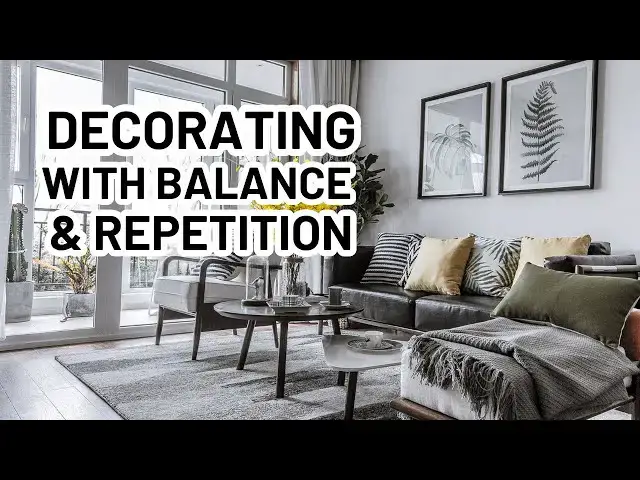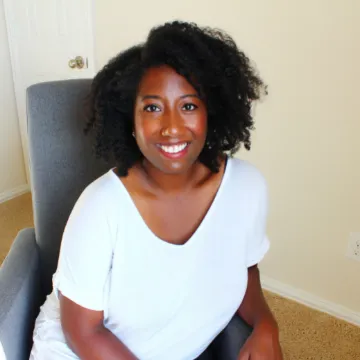Want your home to look more polished, cohesive, and professionally designed—without spending a fortune? In this video, I’ll show you how to use two powerful design principles—balance and repetition—to transform any room in your home.
These interior design principles work in every style—from modern farmhouse to coastal, traditional, or minimalist. Once you understand them, decorating becomes so much easier (and way more fun!).
If you love practical decorating tips that make your home feel calm and cohesive, hit subscribe for more videos like this every week.
| CHAPTERS |
00:00 Intro
01:50 What Is Balance?
05:29 What Is Repetition?
08:25 Conclusion
09:04 Outro
| BLOG POST |
✨| FREE DOWNLOAD |✨
Show More Show Less View Video Transcript
0:03
Hi, it's Lindsay Diane from diancor.com.
0:07
In this video, let's talk about balance
0:09
and repetition.
0:11
There are no rules to design, but there
0:14
are interior design principles that have
0:17
been proven over time to yield pleasing
0:21
results consistently. And interior
0:24
designers study and master these
0:26
principles. And it allows them to create
0:30
beautiful and cohesive spaces. Having
0:33
this knowledge allows them to analyze,
0:36
critique, and improve upon a space
0:39
quickly and easily. Unfortunately, most
0:42
of us do not have the luxury to hire an
0:45
interior designer to help us with our
0:48
home decor choices. So, we're left to
0:51
sort of fend for ourselves and figure it
0:53
out as we go. And this often leads to an
0:57
uphill battle of trial and error. So in
1:01
this video, I want to break down two of
1:03
the most impactful design principles,
1:06
balance and repetition. And I'll show
1:09
you how to use them so that you can
1:12
easily and consistently create visually
1:15
pleasing spaces throughout your home
1:17
without the help of an interior
1:19
designer. While there are several
1:21
interior design principles that
1:23
designers reference, the two most
1:26
impactful ones are balance and
1:28
repetition. These two principles form
1:31
the groundwork for other key concepts
1:33
like unity or cohesion, hierarchy, and
1:37
rhythm. Understanding balance and
1:39
repetition will help you create rooms
1:41
that feel just right. They're not too
1:44
cluttered. They're not too sparse. And
1:47
they are effortlessly harmonious. So,
1:51
what is balance? Balance is one of the
1:53
most fundamental design principles in
1:56
interior decorating. It refers to the
1:59
visual distribution of weight within a
2:01
space. When a room feels off, it's often
2:04
because it's visually unbalanced.
2:07
There's too much furniture or color on
2:09
one side and not enough on another.
2:12
Balance ensures that the eye moves
2:15
comfortably throughout the room without
2:17
fixating on one dominant area. It's all
2:21
about equilibrium and stability in your
2:24
visual field. There are three main types
2:27
of balance to consider. There's
2:29
symmetrical, there's asymmetrical, and
2:32
then there's radial. Symmetrical balance
2:35
is the most classic and formal type of
2:37
balance. Imagine walking into a bedroom
2:40
where there are two identical
2:42
nightstands and lamps flanking either
2:44
side of the bed. That is symmetry and
2:47
action. It's calming, predictable, and
2:50
ideal for spaces where you want a sense
2:52
of order and tranquility like bedrooms,
2:55
dining rooms, and traditional living
2:57
spaces.
2:59
Then there's asymmetrical balance, which
3:01
is a more relaxed approach to balance. A
3:04
quick example of a symmetrical balance
3:06
is right behind me. I have a large tree
3:10
on one side and then behind me
3:14
there is a large floor lamp. This helps
3:20
balance that space. So I'm using
3:22
asymmetrical balance to flank that
3:24
console table in the back. I am also
3:27
balancing the table symmetrically with
3:31
these two
3:33
wall art pieces in the back.
3:36
So there's use of both of those in this
3:39
space. Asymmetrical
3:42
involves arranging objects of different
3:44
visual weights in a way that makes them
3:47
still feel stable. So I have two tall
3:50
elements here in the back. They are not
3:53
the same thing, but they do carry a
3:56
similar visual weight and a similar
3:58
height, and so they help to balance out
4:00
this background. It helps me achieve a
4:03
sense of equilibrium in the space. Then
4:06
there's radial balance, and this is most
4:10
often seen around a table. So, think
4:13
about a round table with a centerpiece,
4:17
like a vase with flowers in it. And then
4:20
you have your placemats and place
4:23
settings sort of radiating out from
4:25
there in a round circular form. And then
4:28
of course you would have your chairs
4:30
that are set at each one of those place
4:32
settings. This is a great example of
4:34
radial balance. It brings your attention
4:37
to the center of that radial point.
4:41
Another way that we see the radial
4:42
balance is when we center our round
4:45
table underneath a chandelier. That
4:48
lighting fixture helps create the core
4:50
or the center and we radiate out from
4:52
that. Another layer to add into this
4:56
would be an area rug. So if you think
4:58
about it from the floor up, you have a
5:00
round area rug on top of which you have
5:03
a round dining table and then you have a
5:07
rounded centerpiece or a chandelier
5:10
right at that center. That's an awesome
5:13
example of radial balance and we see it
5:16
often in our homes.
5:18
When you apply balance thoughtfully,
5:22
your home feels intentional and
5:24
comfortable, a place where every element
5:26
has a purpose and a presence. Now, what
5:30
is repetition? Repetition is another
5:33
essential design principle that brings
5:36
unity and flow into your space. It's the
5:39
intentional reuse of colors, shapes,
5:44
textures, or patterns throughout a
5:46
space. Repetition makes a design feel
5:50
cohesive, and it guides the viewer's eye
5:53
from one part of a room to another,
5:56
creating a visual rhythm.
5:59
Repetition is also a way to create
6:02
balance. So, we just talked about
6:05
symmetrical balance. You are achieving
6:07
symmetrical balance through the
6:10
repetition of an element. So whether
6:12
it's two lamps or two pieces of artwork
6:16
or two plants, it's this repetition
6:20
that's helping you to achieve your
6:22
symmetrical balance. So a lot of these
6:25
interior design principles work in
6:28
conjunction with one another. This is
6:30
just one way that we see those two
6:32
working together. For example, repeating
6:35
a color or material like brass hardware
6:39
on lighting, drawer poles, and mirror
6:41
frames helps distribute visual weight
6:44
evenly across a room. This repetition
6:47
naturally reinforces balance without it
6:49
feeling overly matched or predictable.
6:53
Repetition also is a way to execute a
6:56
color palette.
6:58
If you've chosen a color scheme but felt
7:02
like something was missing, repetition
7:04
might be the key, try repeating one or
7:07
two of your accent colors throughout the
7:09
room. Use throw pillows, artwork, vases,
7:13
or curtains. Even subtle echoes of color
7:16
and small accessories can make your
7:18
design feel deliberate and connected.
7:21
Repetition also builds cohesion or
7:24
unity. A well-decorated home doesn't
7:27
mean that every room looks identical. It
7:30
means that there's a thread that ties
7:32
them all together. I have a whole video
7:35
on cohesive interior design. I will link
7:37
it in the description box below. But
7:40
when you use similar finishes, motifs,
7:44
or materials across different rooms,
7:46
you're establishing unity. For instance,
7:50
if you use ratan in your living room
7:52
decor, consider bringing that same
7:56
texture into your entryway by use of
7:58
like a large oversized basket or into
8:02
your dining room through a light
8:04
fixture.
8:06
These repeated elements help your home
8:09
flow naturally from one space to the
8:11
next. Repetition keeps your decor from
8:14
feeling chaotic. Instead of competing
8:17
elements, your design choices feel like
8:20
they're having a conversation with each
8:22
other. They're creating a unified and
8:24
harmonious home. Understanding and
8:27
applying design principles such as
8:29
balance and repetition can completely
8:32
transform the way that you approach
8:34
decorating your home. Instead of
8:36
second-guessing your choices, you'll
8:38
start to see why certain arrangements
8:40
and color combinations just work. By
8:43
striving for balance, you ensure that
8:44
your spaces feel stable and inviting.
8:47
And by using repetition, you bring unity
8:51
and flow into your home. Together, these
8:54
two principles form the backbone of good
8:57
design. And they will help you create
8:59
rooms that not only look beautiful, but
9:01
are also effortless and intentional.
9:04
That's it for this video. I hope you
9:06
found it helpful. If you would like more
9:08
videos on interior design principles,
9:10
let me know in the comments below. I'd
9:12
be happy to make some more. I thank you
9:14
so much for watching. Don't forget to
9:16
visit me at dianor.com. I post all about
9:19
interior design and home decorating
9:21
ideas over there. If you like this
9:24
video, please give it a like and
9:25
consider subscribing to my channel. And
9:28
thanks again for watching. I'll see you
9:29
in the next one. Bye.
9:32
[Music]
#Home & Interior Decor
#Home & Interior Decor
#Home Furnishings



